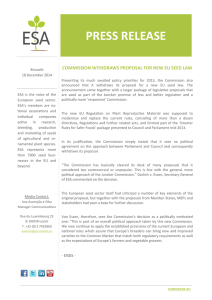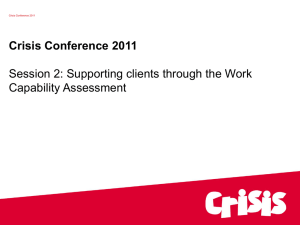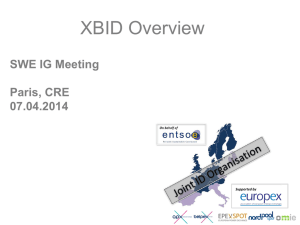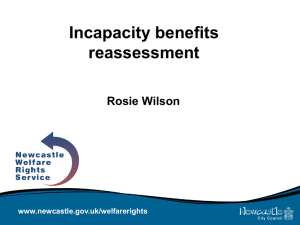Employment and Support Allowance Legislative Changes 2013
advertisement
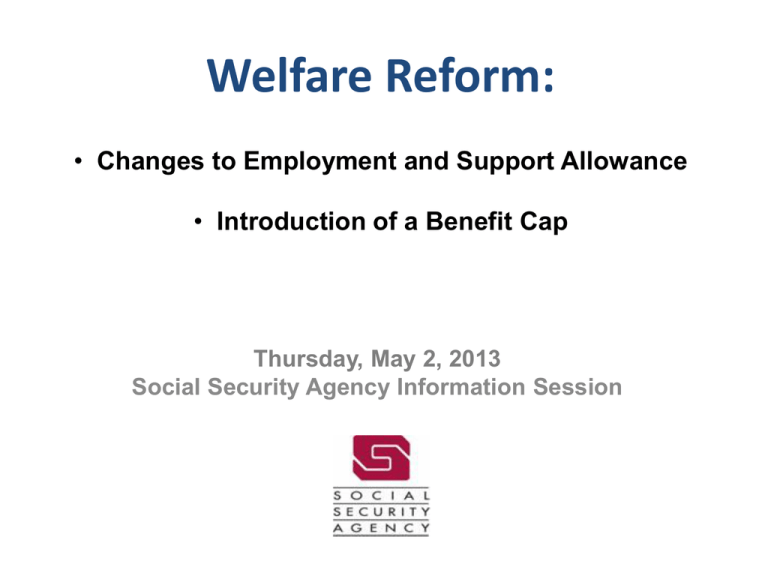
Welfare Reform: • Changes to Employment and Support Allowance • Introduction of a Benefit Cap Thursday, May 2, 2013 Social Security Agency Information Session Introductions 1. Changes to Employment and Support Allowance: Judith Clarke, Denise Monroe, Communications Strand Employment and Support Allowance Project 2. Introduction of a Benefit Cap: Monica Clarke, Benefit Cap: Implementation Manager Mairead Duddy, Benefit Cap: Project Manager What’s in the Bill? 1. 2. 3. 4. 5. 6. 7. 8. Universal Credit Personal Independence Payment (replacing DLA) Reform of the Social Fund Housing Benefit reforms Changes to Employment & Support Allowance Introduction of a Benefit Cap New Conditionality and Sanction powers New Fraud powers 3 Why is reform happening? • • • • Sustainability: The system has become too expensive Simplicity: The system has become too complex Targeted: To ensure resources are focused on those most in need Personal responsibility: To ensure that those who can work are helped move towards work, and not trapped in benefit dependency • Fairer: To make the system fair for those funding it i.e. the taxpayer • Parity: Northern Ireland does not have the capacity to run or fund its own social security system. Cost = £5.1bn per year; more than the cost of running the Health Service in Northern Ireland. 4 Why are the changes being introduced? • Changes to ESA and the introduction of a Benefit Cap are part of the Welfare Reform Bill for Northern Ireland. • Northern Ireland operates a system of parity with Great Britain, meaning that all benefit rules and rates should be the same here as they are in GB. • The changes were introduced in Great Britain in May 2012 and April 2013 respectively. The timetable Assembly Stage Date First Stage 1 October 2012. Completed Second Stage 9 October 2012. Completed Committee Stage 10 October. Completed Deadline for tabling amendments for Consideration stage 9.30am 10 January 2013 Consideration Stage TBC Deadline for tabling amendments for further consideration stage TBC Further consideration stage TBC Final Stage TBC Formal consideration of regulations TBC Royal Assent Expected June 2013 6 1. Changes to Employment and Support Allowance Today we will explain: • • • • • • What is Employment and Support Allowance? What is changing? Why change? Who will be affected and how? How many customers will be affected? How the changes will be introduced. What is Employment and Support Allowance (ESA)? • ESA was set up in 2008 to replace Incapacity Benefit. • All existing Incapacity Benefit customers will be reassessed for ESA by mid 2014. • ESA provides financial help to people who are unable to work due to illness or disability. • ESA also provides personalised support to help people prepare for suitable work. What is Employment and Support Allowance? There are two types of ESA: • Contribution-based, ESA (C). Customers will receive this if they have paid enough National Insurance contributions. • Income-related, ESA (IR). Customers will receive this if they do not have enough money coming in, or they have not paid enough National Insurance contributions, and they satisfy the entitlement conditions. What is Employment and Support Allowance? There are two phases: 1. Assessment Phase: the first 13 weeks of a claim. 2. Main phase: • Support Group, OR • Work Related Activity Group. What is changing? • Time limiting – customers not in the Support Group will receive ESA (C) for a maximum 365 days. (Previously there was no limit). • ESA Youth – removal of the special contribution conditions that allowed some 16 to 24 year olds to qualify for ESA (C) without having paid National Insurance contributions. IMPORTANT: Customers most severely affected by their medical condition or disabilities (i.e. those in the Support Group) will not be affected by these changes. Why change? • ESA (C) for people in the Work Related Activity Group was never intended to be a long term benefit. • To align treatment of ESA Youth so that all customers will need to satisfy the same conditions for receipt of ESA (C). • To simplify the benefit system and to better align ESA (C) rules with contributory Jobseeker’s Allowance. Who will be affected & how? • Customers in the Support Group will not be affected by these changes. • Customers in the Assessment Phase and Work Related Activity Group will be affected as follows: – ESA (C) will stop after 365 days; – ESA (C) “Youth” will stop after 365 days; – Where there is ESA (C) and ESA (IR) entitlement then ESA (IR) will continue when ESA (C) stops; – Potential customers will not be able to claim under the ESA “Youth” conditions when the changes are introduced. The date the changes can be introduced is subject to the passage of the Welfare Reform Bill How many customers will be affected? • 57,100 people in Northern Ireland were receiving ESA as of November 2012. • Of these, 8,224 customers had received ESA (C) in the Work Related Activity Group or Assessment Phase for at least 365 days. • 22% of these customers may have entitlement to ESA (IR). • 6,414 customers. (11% of the 57,100 total ESA customers) could therefore be affected. Figures taken from the Northern Ireland Employment and Support Allowance Information Booklet which is available at www.dsdni.gov.uk How many customers will be affected? • 78% of ESA (C) customers who flowed off the benefit from the Assessment Phase and Work Related Activity Group had been claiming for less than one year and so would have been unaffected by the changes. • 448 customers receiving ESA (C) and ESA (IR) under the ESA ‘Youth’ conditions as of November 2012 – these customers will be unaffected. • 28 customers receiving ESA (C) only under the ESA ‘Youth’ conditions as of November 2012. – 26 customers in the Support Group - unaffected. – 2 customers potentially affected. How will the changes be introduced? Planning assumption is that: • Prior to introduction of the changes a letter will be issued to all customers likely to be affected by the changes. • Following this the ESA Centre will be contacting customers who are likely to be affected by the changes and inviting them to apply for ESA (IR), if they meet the criteria. This activity will commence 8 weeks prior to introduction of the changes. ESA Existing Customers ESA (C) Support Group Customers not affected Agency calls customers to advise of the date that ESA (C) will exhaust and invites applications for ESA (IR) if appropriate 3 1 2 Agency issues a letter advising of proposed changes to ESA (C) Customer applies for ESA (IR) and receives a notification advising of outcome. Customers who do not apply for ESA(IR) move to touchpoint 7 ESA (C) exhausts a letter is issued to advise that ESA (IR) is now payable. The amount of benefit does not change 5 A letter is issued to advise ESA (IR) is not payable and credits only will continue from the day after ESA (C) exhausts 4 6 7 Letters issued to customers who will automatically move to ESA (IR ) when ESA (C ) exhausts ESA (C) exhausts, a letter is issued to advise that credits only will continue from the day after ESA (C ) exhausts 1 New ESA customers who claim after introduction ESA (C) Support Group Customers not affected Agency assess customer for ESA (C) and ESA (IR) entitlement Letter issued to advise that customer is entitled to ESA (C) and (IR) and ESA (C) is payable for a maximum of 365 days Letter issued 56 days before ESA (C) exhausts 5 4 3 1 2 6 7 Customer makes a claim to ESA (C) – invited to make a claim to ESA (IR) if appropriate Letter issued to advise that customer is entitled to ESA (C) only and ESA (C) is payable for a maximum of 365 days ESA (C) exhausts after 365 days, customer moves seamlessly to ESA (IR). The amount of benefit does not change. ESA (C) exhausts after 365 days, customer continues to receive ESA Credits Only from the day after ESA (C) exhausts 8 Letter issued to customer 56 days before ESA(C) exhausts 1 Reassessed Incapacity Benefit Customers on ESA (C) ESA (C) exhausts after 365 days, a letter is issued to advise that ESA (IR) is now payable. The amount of benefit does not change Customer applies for ESA (IR) and receives a notification advising of outcome As a result of reassessment customer is entitled to ESA(C), Agency telephones customer to advise of reassessment decision, to advise that ESA (C) is payable for a maximum of 365 days and invites an application for ESA (IR) if appropriate. 4 ESA (C) exhaust after 365 days, a letter is issued to advise ESA (IR) is not payable and credits only will continue from the day after ESA (C) exhausts 2 1 3 5 Allowance notification issued which advises that ESA (C) is payable for a maximum of 365 days and includes details of how to apply for ESA (IR) ESA (C) Support Group Customers not affected 6 ESA (C) exhausts after 365 days and a letter is issued to advise that credits only will continue from the day after exhaustion Summary • Customers in the Support Group will not be affected by time limiting. • Time limiting will affect customers receiving ESA (C) including those who qualified under the current ESA Youth conditions – payment of ESA (C) will be limited to 365 days for those in the Work Related Activity Group or Assessment Phase. • ESA ‘Youth’ conditions will be removed. Questions For more detail go to: www.dsdni.gov.uk 23 Where you will find... 24 2. Introduction of a Benefit Cap Today we will explain: What the benefit cap is What is changing How many households will be affected and how How the changes will be introduced and when How affected households will be supported What is the Benefit Cap? An upper limit to the amount of state support that households can receive It will ensure households with no-one in work do not receive more (in benefits) than the average working household. It will only apply where Housing Benefit is in payment What is the Benefit Cap? The upper limits for benefit cap are:- A maximum of £350 a week (or £1517 per month) if the customer is a single person and either: has no children; or the children they have responsibility for do not live with them. A maximum of £500 a week (or £2,167 per month) if the claimant is either: a couple, with or without dependent children; or a lone parent with dependent children. What is the Benefit Cap? Benefits included in the cap calculation:- • • • • • Bereavement Allowance Carer’s Allowance Child Benefit Child Tax Credit Employment and Support Allowance (except when support component is awarded) • Guardian’s Allowance • Housing Benefit • • • • • • Incapacity Benefit Income Support Jobseeker’s Allowance Maternity Allowance Severe Disablement Allowance Widowed Mother’s/ Parent’s Allowance • Widow’s Pension What is the Benefit Cap? Exempt Benefits/Income: Working Tax Credit (do not have to be in receipt of WTC). Employment and Support Allowance (if Support Component awarded) Industrial Injuries Benefits Armed Forces Compensation Scheme (AFCS) (Guaranteed Income Payments), Armed Forces Independence payment (AFIP); and, before 6 April 2005, the War Pension Scheme (WPS) (this includes war widow's/widower's pension and war disablement pension); and Attendance Allowance Disability Living Allowance and its replacement Personal Independence Payment What is the Benefit Cap? Certain one off payments are disregarded: Discretionary Housing Payments Rates element of Housing Benefit Budgeting Loans Community Care Grants Crisis Loans Sure Start Maternity Grants N.B: This list is not exhaustive What is Changing? Currently there is no limit to the amount of benefits households can claim The introduction of a benefit cap will: Promote fairness between those receiving benefits and those in work Ensure that being in receipt of benefit is not seen as a barrier to finding work How many households will be affected? Only 620 NI households will potentially be affected Of those: 40 households have 3 children or less 140 households have 4 children 460 households have 5 children or more And how: Average impact is a reduction of £53.00 per week N.B: Due to rounding figures above do not total to 620 How the changes will be introduced? Initially the cap will be deducted from Housing Benefit In the longer term the cap will be applied as part of Universal Credit And when: Upon Royal Assent of the Welfare Reform Bill How affected households will be supported? Early identification of the affected households Direct contact with each individual household Issue of a Maildrop to: 1. Explain the benefit cap; and 2. Signpost customers towards available support How affected households will be supported? Other support available: Northern Ireland Housing Executive: Help to claim Discretionary Housing Payment Help to seek more affordable housing Department for Employment and Learning: Help in seeking work Her Majesty’s Revenue & Customs Help to claim Working Tax Credit For more detail go to: www.dsdni.gov.uk 37 Where you will find... 38 Questions
